Hags were horrible witches of wicked intent and ancient origin,[5][7] dark fey tied to primal forces[10][11] whose foul magic and mysterious malevolence haunted fairy tales and nightmares.[7][12] Equal parts hideous and heinous, hags embodied what it meant to be ugly inside and out, taking on the forms of unsightly old women.[2][4] They were the antithesis of Feywild natives like the eladrin, for they were warped reflections of civilized beings that epitomized nature at its most repugnant.[3][10][12]
Description[]
Hags were almost universally unique in their exact forms and mannerisms, but there were typically common physical traits between them.[4][10] Generally, hags looked like crooked crones, wrinkled and withered women of unsightly appearance with blotchy skin marred by warts and moles. Their long, skinny fingers were tipped by talon-like nails as tough as steel and as sharp as blades, and their mouths were filled with sharp, blackened teeth and noxious breath. Long, frayed hair ringed their creased faces, but even though their faces were heavy from their malice, the glimmer of sly villainy could still be seen in their eyes.[1][4][5]
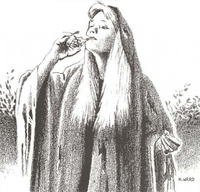
A nymph drinks a potion brewed by a hag...
Normally hags wore simple clothing like those of female peasants, if more ragged and dirty, but not for a lack of interest in their appearance.[1][5] In fact, hags were very concerned with their appearance, taking steps to ensure they were at their worst by rubbing filth onto their clothes and accessorizing their gross garb with gruesome decorations. They would modify their clothes with bits of gore and refuse, wear bits of skin and bone, spin cloth from innards and put all manner of litter in their hair, and those were only the things they would wear. They were also known to augment their actual bodies, such as by sharpening their teeth to make themselves more fearsome, picking at scabs to produce weeping sores, and otherwise exacerbating their deformities with nurturing attentiveness.[1][2]
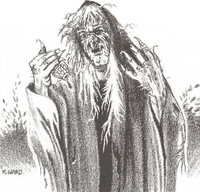
...to return to her former hideousness.
However, if a hag needed to not invoke utter disgust, they could magically disguise themselves, the exact limits of their illusions being specific to different types. Almost all types could take on the forms of regular old ladies,[1][10] but some could appear to be attractive youths, diminutive giants and even vaguely humanoid animals like bears.[10][14] Regardless of what guise they donned or act they put on however, such impersonation would always be superficial, because the physical forms of all hags were merely reflections, the twisted moldings of the ugliness in their own hearts.[1][2]
Personality[]
Evil was at the core of what defined hags, an inextricable part of their identity. They were representatives of malice and malignancy, paragons of corruption[1][2] who took unbridled joy in creating misery and misfortune for the virtuous and content. To simply call them evil was itself an understatement; petty, avaricious, conniving, merciless, abhorrent, and oppressive simply scratched the descriptive surface.[2][3][10] Their reversed sense of value extended to aesthetics as well, for hags were known to relish their moral and physical ugliness, as well as the horror that they evoked, and be disgusted by the beautiful to the point of disfiguring those who were attractive.[1][2] Despite embodying that which was horrible and brutal in nature, they still disrupted the natural order,[10] for hags were miserable creatures of scorn and hate that did evil purely for evil's sake.[4]
Unpredictable[]
Even to immortal beings, hags could be unfathomable in their decision-making and it was almost impossible to predict how they would act at any given time, much less during any given day.[2] Making them even less understandable was that hags were keepers of forbidden knowledge that would be better off forgotten, although fortunately they were greedy beings and so typically kept it to themselves. Whether obtained from dark divinations, arcane pacts or from other hags, their knowledge was fearsome and made them even more dangerous than they would be otherwise.[2][15]
In the event that a hag was acting friendly, or at the very least ambivalent, it was important to remember that hags ultimately didn't care about the thoughts or desires of anyone but themselves. Like cantankerous grandmothers, hags viewed those younger than themselves with opinionated stubbornness, freely and bluntly saying whatever idea came to mind. These could be lewd jokes or comments at their expense or more threatening asides about various means with which they could be harmed, and by no means were hags hesitant to make good on these statements if made to lose their tempers.[2]
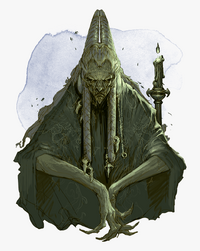
Baba Lysaga, an ancient hag capable of love.
The schemes of hags were patient, their webs of manipulation wide, and their understanding of mortal vices, as well as how to manipulate them, great.[2][10] Sometimes they wished to bring devastation to a benevolent community or destroy some being of good and at others their machinations were a net positive for the multiverse, such as the defeat of a fiend or rival hag coven.[2][15] The end game behind a hag's actions and requests, even incredibly simple ones, might only come into play decades later under certain specific conditions, but in any case they almost certainly involved directly or indirectly gaining leverage for some undoubtedly nefarious plot.[2] However, even creatures as indisputably vile as hags were known to show affection for certain things other than themselves, some even going so far as to demonstrate motherly devotion towards others, although by no metric was this a common occurrence, nor did it necessitate such hags be generally benevolent or proud of this fact.[2][16]
Bargaining[]
Despite their myriad flaws, hags were not just willing, but happy to make bargains with others, although not out of any sense of genuine generosity. The baleful busybodies enjoyed sticking their noses in other people's business, offering deals that required one to either compromise their values or do something to make the deal ultimately not worth it. For a hag, the bargain was the most delicious way to fell a mortal because they would be complicit in their own wonderful corruption, making it much more enjoyable than blatant violence or straightforward tyranny.[2][1]
In terms of bargaining behavior, hags could be compared to fiends, both of which used their many resources to make deals with mortals in order to corrupt them, but there was a fundamental difference between the two. Whether devil or demon, fiends typically made deals with mortals ultimately to obtain the soul, a powerful and versatile commodity that would grant them greater status, with the mortal's induction to a particular vile ethos being the means of obtaining it. The emotional state of their marks by the end wasn't necessarily a relevant factor to the fiendish corrupter.[2][1]
Unlike fiends, hags approached the bargain from the perspective of a hobbyist, corrupting mortals for the fun of making others miserable and not caring about their particular cosmic fate. Obviously such a dichotomy didn't always apply; fiends generally enjoyed torture and torment and hags were known to make deals for purely pragmatic reasons, even if doing so didn't actively ruin anyone's lives.[2][1]
Weaknesses[]
Hags tolerated little disrespect in regards to mortals because all possessed at least one crippling weakness: arrogance. Hags treated almost all other beings, particularly humans and demihumans, as inferiors, believing themselves to be the most cunning of all beings.[1][5] This natural sense of superiority was, in some cases, unwarranted,[12] and while they were extremely clever, their confidence could lead them to accidentally reveal something during conversation that the more cautious wouldn't let slip.[5]
If one did need to make a deal with a hag, the best way, if one could be said to exist, was when one could offer the hag something they needed or wanted. In the mind of the hag, part of their compensation for any given service was the suffering of the other party, and giving them something they genuinely desired made the matter more about sating their greed than their sadism. Because hags weren't subtle about self-expression, it would immediately become clear when a hag wanted to have or observe something, such as an odd spell, magic item, or person with bizarre magical abilities, sometimes snatching the object out of the holder's hands to perform more thorough examination. They would smell, shake, taste, feel, and hear the subject, person or otherwise, whispering to themselves before finally placing a mental value on it.[2]
A bribe that would be either unique or useful, or at least enough so to a rival that she wouldn't want her to have it, a hag would pay a high price to obtain.[2] This could possibly be in the form of freeing captives or granting requested knowledge regarding local lore, evil creatures, or mysterious magic, and such deals were unlikely to have dire consequences.[2][1] Better still would be to offer the hag a gift without asking for anything in return, all the better if the service was performed outside of any bargaining context. The foul fey hated being in the debt of others, and while this kind of service was less predictable it was also less likely to be a trap of some sort. But even if a deal made with a hag was simple, seemingly generous, or even actually fair with no strings attached and no harm to anyone around her, a hag's motivations were still hidden and cryptic.[2]
Abilities[]
The powers of hags were as variable as they were, but there were several common abilities between them. The decrepit frame of hags belied their supernatural strength and swiftness, for the crones could crush smaller beings one-handed and easily jump obstructions in their path.[4][5] They all had magic to some degree, commonly being capable of creating illusions to hide their true forms, and they themselves were naturally resistant to magic.[1][5] In addition, hags often knew curses and other wicked rites that allowed them to scry, prophesy, manipulate the weather, and place curses on those that annoyed them.[3] Uniquely, hags possessed the ability to imbue common mushrooms with their essence as a safeguard against death. These enchanted fungi acted as repositories for the hag's life force, allowing them to revive themselves unless the mushrooms were destroyed by fire.[13]
Combat[]
When hags were uninterested in bargaining and were simply looking for someone to harm for whatever reason, they often did so in the guise of human or demihuman females, either young or old but generally helpless, or by taking on the form of creatures like orcs or hobgoblins. If her targets were more powerful or numerous than she initially presumed, or if she was aware that they were too strong to directly confront, a hag would keep the ruse going longer to make her victims more vulnerable, such as by leading them into a trap or persuading them to make unwise decisions. This scheme typically ended with her revealing her true nature and attacking the victims while they were still within killing distance.[5]
Hags were also known to use certain magic items they had on them, whether having intended to use them at the start or deciding to later, and hags being what they were, it was impossible to know what specific tricks they would have up their sleeves. Under normal circumstances, these resources would be used conservatively, but when their lives were at risks they would use any item in order to save themselves. Better to have spent a valuable resource and live long enough to possibly replace it than to die and lose everything they had.[2]
Escape[]
Hags always kept at least three home escape plans, one for general threats and two for likely situations like certain hazards or enemy attacks, in mind if they became outmatched, or just if the need to quickly vacate the premises presented itself. These plans used a combination of innate magic, supernatural items and techniques, guile, and help from others. After escaping, they would immediately plot to serve cold revenge back to the interlopers or their families, even if the original mortal was long dead.[2]
Before even getting to that point however, hags made aware of a serious danger would make use of every dirty trick in the book to try and gain an upper hand. If threatened by a legitimately threatening force, they would feign weakness to prey on braggarts or the merciful so as to be spared, or at least buy time. They would lie, cheat, bribe, cajole, shame, tempt, terrify, divide and otherwise exploit their enemies in any way they believed would work, relying on shrewdness born of age to defeat superior opposition. For example, a hag might offer some secret knowledge or magical item to her assailants in exchange for their lives, holding back parts of the identification or delivering instructions that could backfire with curses or unseen side effects.[2]
Typically a mortal would have to be the one to start hostilities, because hags would rather combat those incapable of defending themselves than fight fairly, attacking the weak or sleeping rather than the tough and alert.[2] Though a hag's claws were dangerous weapons, their favors had fell far more opponents,[10] and if they were resorting to their nails it was a good indicator that something had gone seriously wrong.[2]
Society[]
Hags had no desire to be tied down by others, taking pride in their independence from the rest of the world, including from other hags. Nonetheless, despite how different they could be, all hags recognized each other as kindred spirits, members of a kind of sinister sisterhood by which they were undeniably connected.[2][10] Even though hags didn't like each other, they were still members of their shadowy sorority and as such had to abide by an ageless code of conduct when dealing with one another.[2][1] For example, they always had to announce their presence when entering another hag's territory, bring gifts when entering another hag's home, and keep oaths made to other hags, at least so long as their fingers weren't crossed.[1]
Like all sisters, hags squabbled and bickered, and at worst these rivalries became century-spanning feuds of manipulation and counter-scheming. This sisterly bond meant they might also reconcile, perhaps if a source of mutual hatred presented itself,[10] and while these relationships were largely lacking in emotion, they were often the closest hags had to "friends".[2] Because all hags kept at least some contact with one another, trading secrets, gossip, and warnings through a vast network of magic, personal visits, and messengers, even an utter hermit of a hag had some awareness of surrounding events,[2][15] and most hags could be said to have at least some vague, secondhand information about any other hag.[1]
This also meant that hags were aware when one of their kind was attacked or killed, to which they could have all manner of responses. Hags that were liked might be avenged, those who owed debts might have that debt moved to the killers, and hags that were hated or had debts to hold over others were happily sent off and the killers treated to relative cordiality. All hags were members of a grander pecking order both within their subrace and in the hag race as a whole, determined by age, powers, influence, allies, and experience. Some of these things were earned, while others were inherited from the hag that spawned them, so the determinations of a hag's status were by no means fair. In this, at least to the eyes of mortals, incomprehensible hierarchical web, almost every hag knew their rank and vied in the chaotic system to raise it to a satisfactory point.[2]
Coven[]
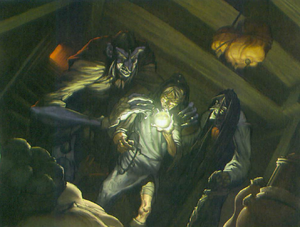
A coven composed of (left to right) an annis hag, shrieking hag, and green hag.
Hags typically shuddered at the thought of having to share their homes and under ordinary circumstances would do no such thing.[2] However, if something required hags to put forth a unified front, either a common goal or threat which couldn't be completed or defeated alone, then they would combine their efforts to form one of the infamous hag covens or coveys.[2][4] This was only done as a necessity since it required the bickering beldames,[2] who in fairness were often like-minded to some degree,[10] to both deal with the inconvenience of living with other hags and suppress their instinctual selfishness to treat each other as equals.[2][1]
Though they behaved with some semblance of civility, coven hags still wanted to increase their personal power, and so the third coven mate served to deal with disputes when the other two inevitably started arguing. Three was the typical number of members in hag covens,[1] most commonly with each hag being a different type,[4] but any grouping of hags larger than that, the maximum in a single coven being thirteen, usually ended in catastrophe.[1][10]
Motive[]
Still, the act of forming a coven still came with enough advantages to offset its annoyances for most hags, so they were not uncommon.[2][10] For one, hags in a coven were able to put together forces with greater variety. Whereas a single hag could trick the dryads in a nearby glade into doing as she wished or bully the resident ogres of an area into following her commands, a coven could martial many diverse forces, the most powerful covens being capable of ruling kingdoms, whether on or behind the throne.[10]
The other, more direct advantage, was that hags working in a coven obtained powers far beyond what they could achieve alone through a combination of their individual ritual magic. So long as the hags of a coven remained close to each other, they might gain powers such as the ability to scry, control the weather, command nature, create plagues, divine the future, lay wicked curses, defeat some goodly champion, or manipulate death, depending on what mission they were bending their magic towards.[2][10] Covens with more powerful hags could gain even greater control over their immediate environment, but only if the hag in question desired them to and possibly only during certain time periods or under specific conditions, depending on the strength of the hag in question.[2]
When a coven member was killed, the survivors tried to recruit a replacement to keep the group together, effectively starting tryouts where applicants competed to prove their malice. In some ways, this could be more dangerous for the surrounding area in the long-term then if the original hag hadn't died at all, as natural and supernatural disasters plagued the region. Sometimes uniquely gifted and particularly wicked mortal spellcasters, like wizards, sorcerers and even warlocks, would be invited or allowed to compete for a spot in a coven, typically if the pair of hags had some use for the unusual member. For example, they would make an excellent spy in humanoid settlements, although given the hag opinion of mortals, this could be a potentially dangerous arrangement.[2]
Lairs[]
A hag's lair, no matter it's form, was an unpleasant, disturbing thing which, like her form and magic, was a representation of herself.[2][1] This was when they weren't actively twisting Feywild magic to twist their homes to better fit their macabre tastes and dark senses of humor.[10] Normally there was some element of corruption and death; a dead tree, a cave resembling a skull or possibly an actual giant skull. At other times they were more obviously manufactured, resembling taverns, ruined towers, mausoleums, giant coffins, and even gingerbread houses.[2][1]
There was always some defense system in place, whether it was a naturally dangerous path, magical wards, or disguised captives to lure in the less prepared. They made their homes around mortal settlements, not so close as to be an obvious threat but close enough that a steady supply of malcontents could occasionally come seek her out.[2][1] The most powerful hags were known to have more direct control over their lairs, able to pass through its walls and magically lock and open its doors and windows at whim.[2]
Language[]
Hags were said to have their own incredibly ancient language,[8][9][5] but also spoke various others such as Common, Giant, Draconic, Sylvan, and various demihuman tongues.[2][5] Their names were given to them by their predecessors, but ultimately decided by the hag in question, the birth name potentially influencing the decision, and they were usually whimsical in a black comedy sense. Typically they consisted of a first name and then either a preceding title or last name to follow it. Titles might refer to a negative personality trait, bad feeling, physical deformity, or matronly position, while last names often combined different body parts, animals, plants, or gross substances. Though hags were known to adopt different names when in disguise, their originally chosen title was still their favorite.[2]
Relations[]
While typically solitary, hags occasionally felt a desire for companionship, something they typically sated by collecting servitors. In no sense were these entities friends; the hag either charmed the servant or had some way to threaten its life, either magical or mundane, and would insult and beat them on a whim. Even ordinary animals were retained as minions, commonly for the purpose of self-defense, a task for which bound mortals were the most delightful pawns. Innocent folk were an excellent defense against righteous opponents and their unassuming appearance allowed them to act as a hag's eyes and ears, whether they were acting as spies or representatives. Typically a hag's minions could be divided into two groups, the first being servants like constructs, undead creations, unintelligent vermin, and other things that a hag could trust to unquestionably obey their orders and protect her home.[2]
The other type were brutes, mercenaries under a hag's employ with free will that ran errands, roughed up assigned targets, patrolled unimportant areas and otherwise attended to laborious tasks beneath the hag's personal attention.[2][15] Though hags were known to employ ogres, the term brute was generally misleading since hags preferred employees willing and capable of cunning cruelty as opposed to strong but stupid bumblers. These could be other kinds of evil giants, lycanthropes, dark fey, sneaky creatures like bugbears, kenku, and doppelgangers, or other strange monsters like ettercaps, gargoyles, [2][4] and aberrations.[15]
Hags were also known to augment their minions, whether brute or servant, giving them magic items and disguises or, whether intentional or not, twisting them into villainous fey versions of themselves. These wicked parodies were given powers befitting the hag's nature or that the hag thought would be useful, like limitless stamina, resistance to a certain element, transformations, or teleportation.[2][4][5]
Hags were curious about other beings of power, including other hags, dragons, fiends, genies, and sometimes even mortals of great power, and had some small sliver of respect for those with accurate knowledge of such beings. Given their magical and political prowess, dangerous beings might be under a hag's sway, whether returning a favor or paying off a supernaturally enforced blood debt.[2] Hags were known to put themselves in servitor positions, offering their dark knowledge to powerful evil entities, but whether as oracles or simple advisors they were typically unfaithful to their masters if presented with a chance to usurp.[3][15] Conversely, the heinous deeds of hags earned them powerful enemies, good-aligned dragons and giants being known to hunt them and kill them if given the chance.[5]
Mortals[]
When hags made deal with mortals, the true consequences were often hidden, with the deal-maker in question sometimes even enjoying success for a time before a drawback presented itself. Those that came to them could find that a trait bestowed on a loved one had become too extreme, created some other flaw in them, or created a situation where the mortal was dependent on the hag. Desperation was the best bargaining tool of a hag, the common factor in a majority of their dealings being that others sought them out for help even when aware of their wicked ways out of sheer sense of necessity. Hags rarely looked for mortals to bargain with because their desire to make offers and enforce deals was outweighed by their love of being in positions of power, something that she gained when someone came to her instead of vice versa. This was especially useful if the visitor wanted to avoid being known to have dealings with the hags, adding time pressure to her list of advantages, and they were known to sweeten deals by including obviously exploitable loopholes.[2]
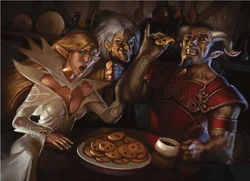
An "old woman" offers her fey visitors cookies.
Even when clear evidence of a hag's negative influence on others lives was plain to see or common gossip in a town, they would still receive visitors from those foolish enough to believe she would show altruism. Some tried to invoke the hag code of conduct, not aware that those outside the sisterhood got no such courtesy, although the hag in question might play along for a while before revealing the invoker's folly. Out of a belief they were smarter, had less distortable desires, or were simply less greedy than those before them, there were those occasional few who continued to deal with hags and whose deals each hag remembered down to the letter. After years of slowly corrupting mortals one at a time, a hag's community of choice would run out of benevolence and the residents would become grim and hostile towards outsiders as a result of their own misery. Yet hags didn't completely crush all hope in a community; by providing the slightest glimmer of a chance that she would undo some of her foul works, hags kept leverage over the communities they corrupted, and so local leaders did what was in their power to stop interlopers from trying to defeat her.[2]
Fey[]
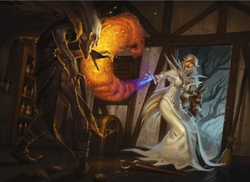
A hag turns on her fellow fey with cookies that turn others into rabbits.
Though the former leant towards good and the latter towards evil, both the Seelie and Unseelie Courts of the fey were admirers of true beauty and so both were relatively absent of hags. Even with their knowledge and magic, hags were only accepted as courtiers in courts if they were weak or humble enough to create a less hideous guise to prevent them from staining their surroundings. Given their love of personal freedom, hags had no problem with not being bound by the fickle whims of a fey queen. However, compared to their dealing with mortals, hags dealt with fey creatures,[2] and other powerful creatures in general,[5] with greater respect. Not only were fey stronger than mortals, and thus more capable of harming her if they were angered or felt cheated in the dealings, but unlike the short-lived humanoids, a fey creature could spend centuries plotting vengeance. While this didn't make them behave more pleasantly towards fey creatures, since they enjoyed trying the patience of other beings, it made them temper their blatant comments and forceful attitudes based on their knowledge of how much an entity would tolerate.[2]
Religion[]
The arrogance of hags was so unimaginably great that they saw their magic as a challenge to the gods themselves.[1] They blasphemed deities whenever given the chance and often refused to acknowledge the powers that were.[1][7] However, given certain situations, such as a benefit to themselves for doing so, hags were known to put aside their egos and appeal to dark gods, particularly those that might be sympathetic to their plights. While they didn't exactly have a pantheon, multiple hag gods did actually exist, it's just that they didn't necessarily have anything to do with one another.[7]
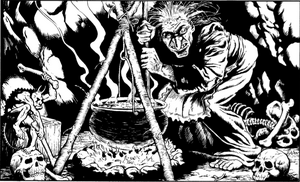
The hag goddess Cegilune brewing something vile in her cauldron.
The patron power of the hags was Cegilune, a bitter moon goddess who herself held a grudge against many divine beings and the countless mortal races who followed them. From the bottom of the multiverse, a pit in the Gray Waste known as Hag's End, she brewed new abominations and used profane magic in her spiteful schemes. Though she did have devotees who praised her virtues while cursing and sacrificing her enemies at gristly shrines, hags for the most part had no love for their own goddess. Most hags feared her for her cupidity, rightly believing that she might demand information, magic, and other spoils they'd rather keep for themselves, but they dared not disobey her.[7][6]
Cegilune herself couldn't care less for the ultimate fate of the hags, distrusting them and generally only seeing them as tools to sate her hatred.[6][17] Given this relationship between patron and benefactor, it was no wonder why she had to trade souls with demon lords to obtain enough magic to sustain her being, seeing as she seemed to cling to divinity only for the purpose of resolving her grudges.[7][6]
Aside from Cegilune, there was also the unpredictable archfey known as Baba Yaga, the so-called Mother of Witches, or the archdevil Malagard, referred to as the Hag Countess. Baba Yaga was a trickster deity whose next moves and methodology were incomprehensible even to other gods, and thus she was only contended with warily. She associated with evil gods yet rarely harmed children or similar beings to avoid bringing down the wrath of superior gods, but there was no action one could take to ensure a successful meeting with her. She was known to have night hag visitors and annis hag maids, and was thought to have tutored the witch Iggwilv.[18][19]
In contrast to the nonsensical mind of Baba Yaga, Malagard was, strangely for a hag, a being of lawful evil, though less so than other archdevils and still relatively driven by whim.[20] The supremely powerful night hag aimed to obtain true godhood and was possibly responsible for her own death in a failed attempt at apotheosis, although whether or not she truly died was debatable.[21][22][23] She viewed lesser night hags as sisters and kept numerous types of hags in her rolling boulder fortress in Malbolge.[20]
Rule of Three[]
Apart from gods, hags were known to be spiritual in sense that they had their own superstitions, the most famous of them being the Rule of Three. The Rule of Three was a planar concept rooted in the realization that many realms and layers in the multiverse were arranged in multiples of three, and hags, as well as other users of witchcraft, were known to embrace the concept. As was said, all things came in groups of three, good, bad, and strange alike. Magic returned threefold upon its source, many spells were cast by chanting a phrase thrice, and covens required at least a trio to function. Though the oldest hags claimed to have invented it, or at the very least named it,[2] the narcissism and lying nature of hags made this seem questionable,[7] and there was also the possibility that some plane-traveling hags simply adopted the idea for themselves.[2]
Magic[]
Over many centuries, most hags discovered certain supernatural phenomena most aptly described as "weird magic". This magic took on a multitude of forms, ranging from unique rituals to magic items, all of which were strange and unusual in the sense that they didn't follow the normal rules for magic. It was impossible to know what kind of weird magic a specific hag might have at their disposal, and even the lowest of them were known to have access to some minor supernatural power. Examples included rites to transform others, temporarily resurrect the dead, rewrite memories, steal emotions, crystallize blood, or invoke razor wind.[2]
Weird magic items could be things like mummified toads that spewed clouds of ink, bottles of wasps that stitched wounds, mirrors that shattered into clouds of glass, jars of death slugs, undeath-sensing eyeballs or containers with memories inside. Not everything in a hag's home was magical; some had magical uses, but others were strange creatures, bits of lore, and things of magical origin. Because all of a hag's treasure was randomly strewn about her home and their organization system was incomprehensible to all but themselves, sometimes deliberately rigged to vex thieves, only the hag knew for certain what everything in their home was, did, how to use them, the trick to using them properly, and whether or not they were trapped in some way. They kept infallible track of all their items, and though they hoarded fine treasure, sometimes even using it to decorate their victims' skeletons, their weird magic was even more invaluable because there was a good chance that it couldn't be replaced or duplicated.[2]
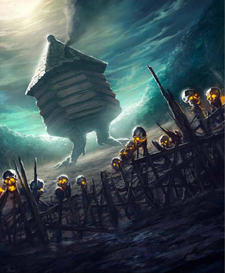
Baba Yaga's infamous Dancing Hut
If a positive thing could be said about hags it would be that they were extremely imaginative, and when it came to travel, the stories of their odd methods of conveyance were largely true. Sometimes they rode atop giant pigs, goats, or cows, and transformed sentient beings into animals like giant birds as a humiliating price for their deals. Others rode in and on clay statues, tombstones, cauldrons and butter churns, or giant versions of bird nests, woven baskets, or mortars. Often only the hag in question could use their transport and would only let another being use them in return for something extremely valuable.[2]
Hag Eyes[]
An iconic part of hag mythology and one of their most potent creations were the magic items known as hag eyes,[12][7] made from gemstones of reportedly varying worth and the real eye of a hag's victim.[1][4][5] Hag eyes required the effort of an entire hag coven to craft, although the details of their creation were possibly malleable. The ritual for creating a hag eye was said to take anywhere between an hour to three days to complete, and required the full attention of the coven to complete. This time was spent in a state of deep concentration and meditation, that prevented them from doing anything besides eating, drinking and sleeping, and anything that disrupted the process forced them to start over again.[1][4][5][12]
At the end of the ritual, the life essence of all hags in the coven was bound to the eye, allowing all members to see what the eye could see so long as it was on the same plane as them, the eye being able to see in the dark. Superficially, a hag's eye appeared as a semiprecious stone but a truesight revealed its true form as a monstrous, disembodied eye. Hag eyes weren't particularly difficult to destroy, and doing so caused all hag's in the coven great mental anguish as well as temporarily blinding at least one of them for an entire day. Creating a new one first required at least a day for the blinded coven mate to recover and had to be done at least three days after the eye was destroyed, some reports stating they could only make one once per month.[1][4][5][12]
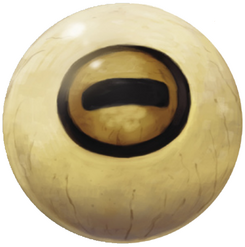
A hag eye
Often hag's eyes were coated in varnish and set into pendants, rings, medallions, brooches and other accessories before being given to unsuspecting enemies and victims as gifts or mementos, allowing the hag to know their every move. They were also commonly given to the minions, familiars and animal companions of a hag and used to watch over their dealings, aid them in patrols and communicate by combining their effect with spells like clairvoyance, sending, or whispering wind.[1][4][5][12] Reports varied on how many hag's eyes a single coven could possess, ranging from just one to an effectively unlimited amount (although this meant creating several weak points for themselves), allowing them to keep watch over their territories with a magical surveillance system.[1][12] Magic items that a hag needed to keep a literal eye on had the hag's eye worked into it so that they could chase down and slaughter the unsuspecting thief.[12]
Hag Brew[]
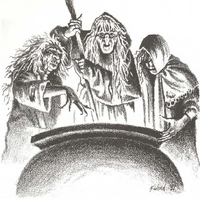
Double, double toil and trouble; Fire burn and cauldron bubble.
Just as emblematic as the hag eyes were the bubbling cauldrons from which hags toiled trouble, combining wicked ritual and cannibalistic feast into a depraved form of mad alchemy. Within the shrieking, writhing soup of primordial ooze rose grotesque monsters and potions known as hag brews, the creation of which was based on similar principles to the creation of a hag eye. Once each month, on the night of a full moon, hags took part in the vile ceremony, which started an hour before midnight and ended an hour after. It required them to stay within 10 ft (3 m) of one another the entire time and prevented them from making hag eyes that month or using their coven abilities the day after, the brewing having already expended all of such magic.[7]
There was the Brew of Black Eyes, a thick, black substance given to those sent by a hag to track something important which required a coven of three different types of hags and a sliver of hag tongue to grant the drinker arcane sight, darkvision, and the ability to see invisibility for a week.[7] Then there was the Brew of the Beloved, a steaming, sickeningly sweet vapor that charmed most creatures that breathed it in, compelling them to obey the orders of the creator coven, although the victim wouldn't do anything if given multiple orders at once and creating it required, fittingly, at least one green hag member. Also of note was the Brew of Cegilune's Blessing, temporarily turning evil creatures that drank it into fiends for a week before permanently debilitating their vitality almost irreversibly.[24]
All hag brews required the sacrifice of a sentient being and various other terrible ingredients depending on the type of concoction. The Brew of Black Eyes for example required a sliver of hag tongue, the Brew of the Beloved needing the warty scalps of each creator as well as the hair of a dozen fair maidens, and the Brew of Cegilune's Blessing demanded a blood-stained idol of the goddess and ample portions of the creators' flesh. The brews of hags might also contain certain adverse side-effects. The Brew of Black Eyes gave the drinker nightmares that prevented them from sleeping properly and allowed the hags to force them into telepathic correspondence. The Brew of Cegilune's Blessing on the other hand rendered any goodly being that drank it unconscious for several hours and sapped even more of their fortitude.[7][24]
Ecology[]
Despite their supernatural natures, it seemed that hags, as well as needing sleep,[12] required sustenance to live. The ravenous hags could devour entire humans in only ten minutes, preferring their flesh to others and consuming that of demihumans or creatures like orcs when needed.[5]
Environment[]
Hags typically dwelt in desolate regions with bleak and oppressive landscapes of all kinds, ranging from dark, thorny forests, gloomy, slogging swamps, bone-strewn glens, misty moors, stormy seacoasts, damp caverns, howling mountains, and biting tundras.[1][10] Specific types had preferred environments but could be found out of them if traveling, part of a coven with more native hags, or if a long-range plan required a long period of time in an unfamiliar region, the lattermost option being most common for older and more powerful hags.[2]
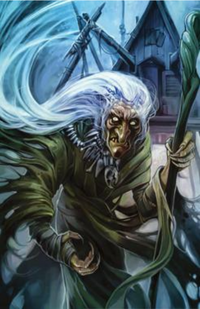
Glurinda, a hag from the Shadowfell
Particularly powerful hags began polluting the environment where they lived, their fell magic and foul nature twisting it just as their own malevolence shaped their powers.[2] The land itself would become hostile, trees and vines attacking and dragging off passersby and fog turning the air toxic while concealing sinkholes and quicksand.[1] In areas where great hags resided, vermin were more frequent, animals were more aggressive towards intruders, and strange figurines, fetishes, and dolls were known to magically appear.[2]
Though hags were known to inhabit both the Feywild and the Prime Material Plane, many were known to settle where the divide between the two was thin, allowing them to interact with beings from both realms. Even ignoring the Feywild, areas where magic energy was strong and the lines between worlds was tenuous were favorable to hags. For example, the ambient magical energy of a burial ground or a ring of fallen standing stones could still hold echoes of ancient, death-related power that a hag would wish to capitalize on.[2] All the standard sub-species of hags, in addition to night hags and silats, could also be found in the Domains of Dread.[25]
Reproduction[]
Given their nature as an all-female race, hags had to find other ways to reproduce beyond the conventional methods. There were many tales of the bizarre means through which hags came into the world; some stories reported that they spawned from animals, like cows with venomous milk or snake eggs kissed by virgins, while other processes were more artificial, like being incubated in the coffins of the unhallowed or being poured out from cauldrons of boiling blood.[10] One of the most widely told tales of hag reproduction had to be that of the changeling.[7][12]
Changeling[]
The exact methodology and timing of it was argued over, but the general idea of the changeling or caliban, was that a hag replaced their daughters with those of other races to continue their lineage. Despite occasionally feeling the compulsion to procreate, hags had no maternal instincts and only rarely raised their spawn themselves if they planned to use them in a coven. Instead, hags had to go out and find a suitable newborn child to kill and replace with their own spawn, parasitically leeching off whatever race or culture the hag targeted as she sadistically watched her daughter's growth and the impact it had on those around them.[1][7][12] Notably, the life of a child consumed by a hag could be saved using a concoction called hag's bane, a substance discovered by Mayrina using the lore contained in The Anatomy of Hag.[13]
Some reports claimed that hags, every century or so, would use some manner of kidnapping, disguise, charming, and coercion to convince almost any kind of humanoid male, humans and half-elves seemingly being preferred, to lie with them.[12][26] After swiftly dealing with that, more often than not killing the male afterwards as an accidental mercy, they would immediately know when they were pregnant and spend nine months in a relatively lethargic state, relying on their allies to protect them although able to fight if needed. The female child produced at the end of this period appeared like a normal member of the father's kind.[12]
The other reported way hags reproduced was far faster, involving the hag simply devouring human infants after stealing them from the cradle and giving birth to, again, an ordinary looking child. Normally this was only done rarely, but it was said that hags sometimes made use of this method in short succession to kickstart their own covens, either as members or masters, or believed based on ancient lore that eating certain types of children, such as twins, triplets or the seventh child of a seventh child, would grant their own spawn rare magic.[2]
Another claimed method was even more direct, the use of magic to swap their spawn with those of other races while the original child was still in the womb, supposedly killing the mother, asleep at the time of the switch, at birth. This claim seemed more superstition than the others and had never actually been proven, although given hag access to weird magic it was difficult to put anything past the ability of their rotten witchery.[2][5][12]
The Change[]
A changeling often appeared normal, even beautiful and healthy for their kind, with their true nature often a mystery even to themselves for most of their lives. However, over time, their hag heritage would begin to show as their forms and personalities were impacted by their ancestry, although not even these bullying tendencies and other bad habits were extreme enough to make them appear like anything but a particularly brutish member of their kin.[7][12]
The amount of time that hags spent dormant was said to vary based on the methods used to bring them into the world, but nonetheless ended in something known by hags as "the change", the final transformation into one of their kind. Those born after nine months typically lived until their mid-forties, showing minor predilections up until that pointed towards traits foreshadowing their futures; young annis hags were often dark-skinned, powerful and aggressive, young green hags attractive prima donnas and young sea hags plain and pale with toxic personalities. Once the mid-forties were reached, more obvious physical alterations occurred until the juvenile was reborn as a true hag of the same kind as her mother.[7][12] The aberrant adolescence of young hags made from devoured children was far swifter, the child only living until their thirteenth birthday before transforming into a near physical clone of their mother.[2]
Lifespan[]
The true lifespan of hags was unknown, and if not fully immortal, they were nevertheless long-lived for many races. At minimum they lived for several centuries and at maximum many millennia, with lifespans comparable to dragons.[2][5] Hags that had grown very old became known as aunties, although they could also achieve that respectable title by adopting or birthing several children, joining a powerful coven or placing themselves directly under an even older hag. The eldest of the hags, as well as the most wise and powerful, were known as "grandmothers" by their sisters, some of which had strength rivaling that of the archfey.[2]
Subspecies[]
Annis : The most physically powerful and feared of the hags, annis hags were ferocious savages with nails and teeth like iron. They were egotistical brutes who saw strength as virtue and appealed to simple-minded beings like children or primitives.[7][2]
Bheur : The unrivaled masters of winter witchcraft, bheur hags were blue-skinned beldames that made cold seasons even harsher than normal. They were cold-hearted crones who reveled in the greed that bad conditions brought out.[2]
Bog hag : A variety of hags that dwelt in swamps, bog hags were predators that hid behind a familiar face. After lying in wait below the water and killing their victims, the sinister body snatchers stole their skin, and sometimes their identities.[27]
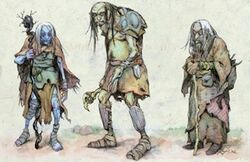
(From left to right) A bheur hag, hagspawn, and shrieking hag
Green hag : The most duplicitous and hateful hags, green hags used illusions and temptation to lead others to destruction and tragedy. The forest femme fatales sought to poison that which was pure and drag down the civilized world into barbarism.[12][1]
Hagspawn : The male counterparts to changelings, hagspawn inherited the strength and endurance of their forebears without the magic or inevitable transformation. They didn't grow into true hags like changelings did, and as such no male hags existed.[26]
Hannya : A variety of hag from Kara-Tur, hannya were similar to yuan-ti, former mortals that struck an unholy pact with an evil being to obtain great power. The serpentine subrace had telepathic powers and a strange aversion to violets.[28]
Night hag : The most vile and nightmarish of the hags, night hags were fey turned fiends, so vile even compared to the rest of their kind that they were banished from the Feywild. The fiendish degenerates were soulmongers who traded larva in Hades for power and wealth.[1]
Sea hag : The indisputably ugliest of the hags, sea hags were decrepit piscine women of such hideousness that one could die from looking at them. The aquatic hags sought to defile and invert all that was beautiful.[1]
Shrieking hag : A variety of hag from Rashemen, shrieking hags had an ear-piercing scream, and roamed desolate wastelands spreading deception, mischief, and chaos. Spiteful and easily angered, they were known to burst into a series of maddening wails if their trickery was resisted.[29][3]
Silat : A variety of hag from Zakhara, silat were a strange subrace known for their unpredictably. Leaning more towards chaos than evil, some were known to be benevolent and kind if approached in whatever manner they deemed "proper".[30]
Metamorphosis[]
It was a common belief of some that there were only five kinds of hags, a misconception. Another unknown fact to many was that hags were able to undergo a metamorphosis so as to change into other subraces of hags. The reasons for why could be anything, some believing that by changing into every type of hag they could become something greater by the end. There were also several ways to gain access to the transformation, some hags simply living long enough to do it through force of will over time, and others using certain resources, perhaps a ritual or coven, to speed the process up.[2]
History[]
The hags were a race of such ancient origins that all that could definitively be said was that they originated in the Feywild, and as embodiments of nature's cruelty they might have existed since its inception.[1][10] Being a race of egotistical boasters and blatant liars, anything they said regarding their believed heritage was at the very least their warped perception and at worst an outright fabrication.[7] They haunted the legends of all cultures, and though a few common tales could be found, it was difficult to tell their veracity.[7][12]
Baba Yaga was said to be related to night hags, green hags and annis hags,[19] and indeed the three types did seem to have some connection, although which ones were the degenerates was difficult to discern.[7][31] The original green hag, according to a story told by elves and orcs alike, was Green Mary, a druid who betrayed nature by consummating with a hunter she was told to punish.[12] The Princess of Elemental Water, Olhydra, claimed that all hags descended from a race of greater sea hags, although given her inherent bias she was just as questionable regarding the matter as the hags.[32] Oni were suspected to have some ancestral link to annis hags,[7] and the silat subrace could only reproduce by coupling with the ogre mages, producing silats when the child was female and oni if they were male.[30]
In the mythology of giants, the existence of "proto" races who bred with the gods to create modern varieties was a typical trope, and proto-hags were among them. Annam All-Father was said in some myths to have mated with a vastly tall ogress who used magic to hide her ugliness, thus producing Vaprak. The story of Karontor's descent had him learn dark, magical secrets from an ancient race of subterranean hags after his banishment by Annam stripped him of his own spellcasting. The hill giant deity Grolantor was said to have collected and interbred the various runts of early giant broods, and to have contributed to the degenerate stock by mating with various earth-bound monstrosities (including medusa-like hags) and Cegilune herself.[33]
Despite these disparate tales, there was one origin story of the hags that included not only the disparate green, annis, and sea hags, but also the hag goddess Cegilune. This legend was corroborated by a myth long held by ogres and hill giants, for what that was worth, and perhaps hinted at the true origins of hags.[7]
Cegilune[]
As the story went, when the world was young and dark, many terrors lurked in the shadows. and so the fearful races sought protection from that which went bump in the night. In response to these prayers, the moon came into existence, and with it a queen to command the light, Cegilune. Cegilune was a silver-haired beauty whose worship spread across the world and who received constant attempts to court her favor. She adopted the most pious and pleasing priestesses as her daughters and granted them powers they were to use to grant her greater status. Her prophets were given the ability to walk on water so as to spread her good word, the songs of Cegilune bestowed beautiful voices to allure others into service and her protectors the strength to protect other worshipers from harm. In her glory days she was feared and wondered, but success breeds complacency and complacency breeds failure.[7]
Cegilune's flaws were already evident as early as when she first appeared. Despite her beauty, she was as mercurial as the moon itself, and she chose her followers partially based on how much the beauty of their forms reminded her of her own. Eventually, she began growing indolent and uncaring, gluttonously partaking in worship while giving little to her followers in return. As new deities began to emerge, all but her adopted daughters left, the rest having bitterly left her in favor of adopting new patrons while mocking the aloof moon goddess. Cegilune was unaware of her waning adoration until her eternal beauty was ended by her first wrinkle. Her good sense eclipsed by anger, Cegilune went on a killing spree, murdering hundreds of her former followers while the children of the moon went on a bloody crusade.[7]
Though this time was horrible, it was merely a phase; Cegilune's hateful response proved unwise as her younger rivals had far more collective worshipers then she did, and those that weren't killed were driven to the dark wilderness of the world. Cegilune herself was left weakened by her tantrum, for even having hoarded her power, the fit left her exhausted and ruined her beauty, leaving her a pale reflection of herself and forcing her too to flee to the deepest, loneliest crater in existence. Her followers found themselves twisted by the malevolence infused in what once was her blessings, her water-walking prophets becoming sea hags, sweet-voiced songs becoming green hags, and powerful protectors becoming annis hags. In more recent times, the hags, still beings of darkness driven by ancient spite, schemed to bring suffering to mortals. The moon goddess herself, now only full of hate, fostered her remaining divinity to bring ruin to the mortal races she saw as traitors and to extinguish the risen stars, in her opinion the impostor gods of the night, that took her place.[7]
Appendix[]
External Links[]
 Hag article at the Eberron Wiki, a wiki for the Eberron campaign setting.
Hag article at the Eberron Wiki, a wiki for the Eberron campaign setting.
References[]
- ↑ 1.00 1.01 1.02 1.03 1.04 1.05 1.06 1.07 1.08 1.09 1.10 1.11 1.12 1.13 1.14 1.15 1.16 1.17 1.18 1.19 1.20 1.21 1.22 1.23 1.24 1.25 1.26 1.27 1.28 1.29 1.30 1.31 1.32 1.33 1.34 1.35 1.36 1.37 1.38 1.39 1.40 Mike Mearls, Jeremy Crawford, Christopher Perkins (2014-09-30). Monster Manual 5th edition. Edited by Scott Fitzgerald Gray. (Wizards of the Coast), pp. 176–179. ISBN 978-0786965614.
- ↑ 2.00 2.01 2.02 2.03 2.04 2.05 2.06 2.07 2.08 2.09 2.10 2.11 2.12 2.13 2.14 2.15 2.16 2.17 2.18 2.19 2.20 2.21 2.22 2.23 2.24 2.25 2.26 2.27 2.28 2.29 2.30 2.31 2.32 2.33 2.34 2.35 2.36 2.37 2.38 2.39 2.40 2.41 2.42 2.43 2.44 2.45 2.46 2.47 2.48 2.49 2.50 2.51 2.52 2.53 2.54 2.55 2.56 2.57 2.58 2.59 2.60 2.61 2.62 2.63 2.64 2.65 2.66 2.67 2.68 2.69 2.70 2.71 2.72 2.73 2.74 2.75 2.76 Mike Mearls, et al. (November 2016). Volo's Guide to Monsters. Edited by Jeremy Crawford, et al. (Wizards of the Coast), pp. 52–62, 159–160. ISBN 978-0786966011.
- ↑ 3.0 3.1 3.2 3.3 3.4 3.5 Mike Mearls, Stephen Schubert, James Wyatt (June 2008). Monster Manual 4th edition. (Wizards of the Coast), pp. 150–151. ISBN 978-0-7869-4852-9.
- ↑ 4.00 4.01 4.02 4.03 4.04 4.05 4.06 4.07 4.08 4.09 4.10 4.11 4.12 4.13 4.14 Skip Williams, Jonathan Tweet, Monte Cook (July 2003). Monster Manual v.3.5. (Wizards of the Coast), pp. 143–144. ISBN 0-7869-2893-X.
- ↑ 5.00 5.01 5.02 5.03 5.04 5.05 5.06 5.07 5.08 5.09 5.10 5.11 5.12 5.13 5.14 5.15 5.16 5.17 5.18 5.19 5.20 5.21 5.22 Doug Stewart (June 1993). Monstrous Manual. (TSR, Inc), pp. 181–182. ISBN 1-5607-6619-0.
- ↑ 6.0 6.1 6.2 6.3 Carl Sargent (May 1992). Monster Mythology. (TSR, Inc), pp. 109–111. ISBN 1-5607-6362-0.
- ↑ 7.00 7.01 7.02 7.03 7.04 7.05 7.06 7.07 7.08 7.09 7.10 7.11 7.12 7.13 7.14 7.15 7.16 7.17 7.18 7.19 7.20 7.21 7.22 7.23 7.24 F. Wesley Schneider (July 2006). “The Ecology of the Annis”. In Erik Mona ed. Dragon #345 (Paizo Publishing, LLC), pp. 64–68.
- ↑ 8.0 8.1 Steve Miller (2000). “Witches”. In Roger E. Moore, Harold Johnson eds. Van Richten's Monster Hunter's Compendium Volume Three (Wizards of the Coast), pp. 206–207. ISBN 0-7869-1613-3.
- ↑ 9.0 9.1 Ed Greenwood (October 1998). The City of Ravens Bluff. Edited by John D. Rateliff. (TSR, Inc.), p. 96. ISBN 0-7869-1195-6.
- ↑ 10.00 10.01 10.02 10.03 10.04 10.05 10.06 10.07 10.08 10.09 10.10 10.11 10.12 10.13 10.14 10.15 10.16 10.17 10.18 10.19 Rodney Thompson, Logan Bonner, Matthew Sernett (November 2010). Monster Vault. Edited by Greg Bilsland et al. (Wizards of the Coast), pp. 164–167. ISBN 978-0-7869-5631-9.
- ↑ Robert J. Schwalb (December 2011). “Dungeon Master's Book”. In Tanis O'Connor, et al. eds. The Book of Vile Darkness (Wizards of the Coast), pp. 64–65. ISBN 978-0-7869-5868-9.
- ↑ 12.00 12.01 12.02 12.03 12.04 12.05 12.06 12.07 12.08 12.09 12.10 12.11 12.12 12.13 12.14 12.15 12.16 12.17 12.18 12.19 F. Wesley Schneider (May 2005). “The Ecology of the Green Hag”. In Erik Mona ed. Dragon #331 (Paizo Publishing, LLC), pp. 56–60.
- ↑ 13.0 13.1 13.2 13.3 13.4 13.5 13.6 13.7 Larian Studios (October 2020). Designed by Swen Vincke, et al. Baldur's Gate III. Larian Studios.
- ↑ Jennell Jaquays (1988). The Savage Frontier. (TSR, Inc), p. 24. ISBN 0-88038-593-6.
- ↑ 15.0 15.1 15.2 15.3 15.4 15.5 Mike Mearls, Greg Bilsland, Robert J. Schwalb (June 2010). Monster Manual 3 4th edition. Edited by Greg Bilsland, et al. (Wizards of the Coast), pp. 108–109. ISBN 978-0-7869-5490-2.
- ↑ Christopher Perkins, Tracy Hickman, Laura Hickman (March 2016). Curse of Strahd. Edited by Kim Mohan. (Wizards of the Coast), pp. 228–229. ISBN 978-0-7869-6598-4.
- ↑ Ed Bonny (1997). “Pox of the Planes”. In Dave Gross ed. Dragon Annual #2 (TSR, Inc.) (2)., p. 104.
- ↑ Alana Abbott (November 2011). “Court of Stars: Baba Yaga, Mother of All Witches”. In Steve Winter ed. Dungeon #196 (Wizards of the Coast) (196)., pp. 1–5.
- ↑ 19.0 19.1 Roger Moore (March 1984). “The Dancing Hut”. In Kim Mohan ed. Dragon #83 (TSR, Inc.), pp. 31–52.
- ↑ 20.0 20.1 Monte Cook (October 2002). Book of Vile Darkness. Edited by David Noonan, Penny Williams. (Wizards of the Coast), p. 157. ISBN 0-7869-3136-1.
- ↑ Chris Pramas (November 1999). Guide to Hell. Edited by Kim Mohan. (TSR, Inc.), pp. 43–44. ISBN 978-0786914319.
- ↑ Robert J. Schwalb (December 2011). “Codex of Betrayal: Glasya, Princess of the Nine Hells”. In Steve Winter ed. Dungeon #197 (Wizards of the Coast) (197)., p. 4.
- ↑ Robin D. Laws, Robert J. Schwalb (December 2006). Fiendish Codex II: Tyrants of the Nine Hells. Edited by Chris Thomasson, Gary Sarli, Penny Williams. (Wizards of the Coast), p. 73. ISBN 978-0-7869-3940-4.
- ↑ 24.0 24.1 F. Wesley Schneider. Powers of the Covey: Hag Brews. Dragon Magazine. Paizo Publishing. Retrieved on 2020-09-10.
- ↑ Kirk Botulla, Shane Hensley, Nicky Rea, Teeuwynn Woodruff (1994). Monstrous Compendium Ravenloft Appendix III: Creatures of Darkness. Edited by William W. Connors. (TSR, Inc.), p. 8. ISBN 1-56076-914-9.
- ↑ 26.0 26.1 Richard Baker, Matt Forbeck, Sean K. Reynolds (May 2003). Unapproachable East. (Wizards of the Coast), pp. 12–13.17.62–66. ISBN 0-7869-2881-6.
- ↑ James Wyatt (October 2001). Oriental Adventures (3rd edition). (Wizards of the Coast), pp. 147–148). ISBN 0-7869-2015-7.
- ↑ Rick Swan (July 1990). Monstrous Compendium Kara-Tur Appendix. (TSR, Inc.), p. 25. ISBN 0-88038-851-X.
- ↑ Richard Baker, Matt Forbeck, Sean K. Reynolds (May 2003). Unapproachable East. (Wizards of the Coast), p. 65. ISBN 0-7869-2881-6.
- ↑ 30.0 30.1 Wolfgang Baur, Steve Kurtz (1992). Monstrous Compendium Al-Qadim Appendix. (TSR, Inc). ISBN l-56076-370-1.
- ↑ Nigel Findley (September 1987). “The Ecology of the Greenhag”. In Roger E. Moore ed. Dragon #125 (TSR, Inc.), pp. 10–12.
- ↑ Ed Greenwood (October 1998). The City of Ravens Bluff. Edited by John D. Rateliff. (TSR, Inc.), p. 96. ISBN 0-7869-1195-6.
- ↑ Carl Sargent (May 1992). Monster Mythology. (TSR, Inc), pp. 73–74. ISBN 1-5607-6362-0.
